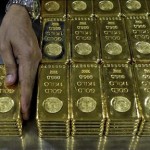Gold edged up on Thursday, drifting further away from a seven-week low, as traders evaluated the prospects of an extended period of low interest rates after the speech of Federal Reserve Chairwoman Janet Yellen. Silver, platinum and palladium were up as well. Copper gained on the back of a softer dollar and hopes for a pickup in Chinese demand in the second quarter.
Comex gold for delivery in April rose 1.36% to $1 217.9 per troy ounce by 10:22 GMT, having shifted in a daily range of $1 219.8-$1 203.4 an ounce. The precious metal edged up 0.35% during the previous session to settle at $1 201.5.
The Fed chief did not point out an exact date on the upcoming lifting of borrowing costs and said that policy makers will discuss the possibility meeting by meeting. Yellen indicated that Fed officials will first drop their “patience” stance on the matter, which in no case will tie them to a certain timetable.
In her testimony before the US Senate Banking committee Ms. Yellen underscored that although the economy is improving, citing a better performing labor market, wage growth remains slow and inflation is still below the targeted level of 2%.
The Fed chair said that the persistent weakness in oil prices plus import prices are weighing on inflation, with expectations for the Fed’s preferred gauge of inflation to hit its desired level in the next two or three years.
However, Ms. Yellen said that once policy makers drop their “patience stance”, a hike in borrowing costs could be announced at any following meeting.
On Wednesday, the Fed chief spoke before the House of Representatives Financial Services Committee, but did not provide any further evidence on when policy makers will initiate their first rate hike since 2006.
Broad expectations had been calling for the central bank to raise interest rates by June, but following the announcements by Ms. Yellen a portion of gold traders now believe the hike will most likely be towards the end of the year.
The US dollar index for settlement in March was down 0.11% at 94.135 at 10:21 GMT, holding in a daily range between 94.315 and 94.075. The US currency gauge slid 0.34% on Wednesday and closed at 94.235. A weaker greenback makes dollar-denominated commodities cheaper for holders of foreign currencies and boosts their appeal as an alternative investment.
The precious metal also benefited from the return of China to the markets, the second-largest gold consumer in the world, following its one week-long Lunar New Year holiday. Gold was trading $4 to $5 higher than the global benchmark in Shanghai, slightly lower than yesterday, but still better than pre-holiday levels.
“China remains a supportive factor for the market. But whether it’s enough to really get prices rocketing higher, I don’t think so, because what you really need for that is a supply shortage and we just don’t have that at the moment,“ said ANZ Bank analyst Victor Thianpiriya, cited by CNBC.
Assets in the SPDR Gold Trust, the biggest bullion-backed ETF, remained unchanged on Wednesday at 771.25 tons.
Copper
Comex copper for delivery in May traded 2.21% higher at $2.7020 per pound at 10:22 GMT, shifting in a daily range of $2.7060-$2.6360. The contract rose 0.15% on Wednesday to $2.6435.
The industrial metal drew support as Chinese markets reopened, with focus pointed toward physical demand in the worlds biggest consumer ahead of the second quarter when it typically peaks. Chinas State Grid Corporation, the largest state-owned electric utilities company in the world, plans to boost investment in 2015 by 9% to a record 420 billion yuan.
The country will speed up construction of water projects to support economic activity, officials said on Wednesday, and is also expanding an income-tax break.
Better-than-expected manufacturing data on Wednesday also helped support copper prices, but bullish sentiment on the Chinese economy remains muted as growth is projected to ease further while analysts expect more aggressive monetary stimulus by the Peoples Bank of China.
The HSBC Flash China Manufacturing PMI rose to a four-month high of 50.1 from 49.7 in January, compared to expectations for a drop to 49.5, while the manufacturing output index reached a five-month high of 50.8. However, a gauge for new export orders slid to the lowest since June 2013.
Hongbin Qu, Chief Economist, China & CoHead of Asian Economic Research at HSBC commented in the report: “Today’s data point to a marginal improvement in the Chinese manufacturing sector going into the Chinese New Year period in February. However, domestic economic activity is likely to remain sluggish and external demand looks uncertain. We believe more policy easing is still warranted at the current stage to support growth.”
A weaker dollar benefited the industrial metal, following Janet Yellens testimony before Congress, while analysts eyed todays consumer inflation, initial jobless claims and durable goods orders data from the US go gauge how well the worlds biggest economy fared. Commerce Department data showed yesterday that new homes sales in the US contracted less than expected in January.





